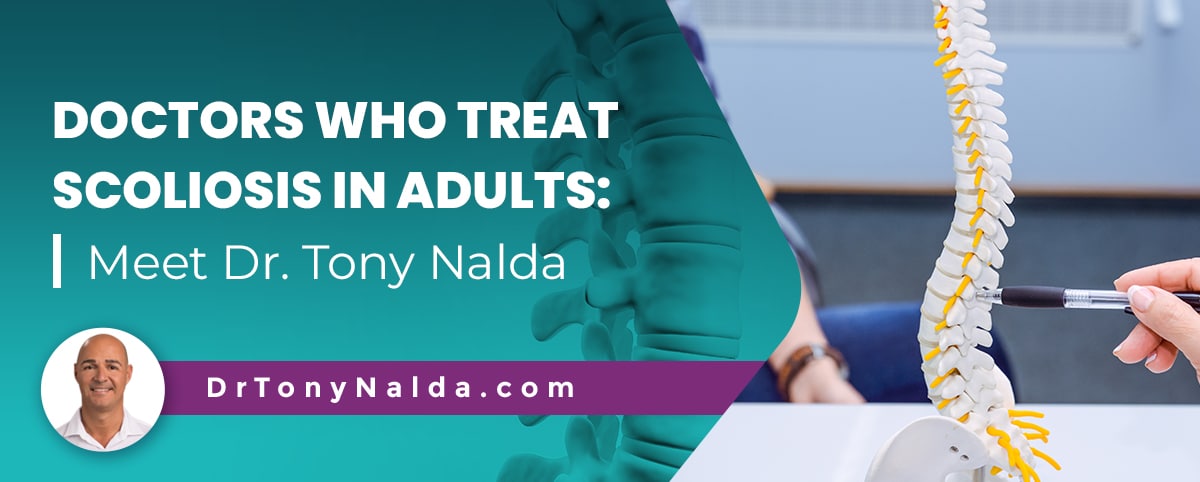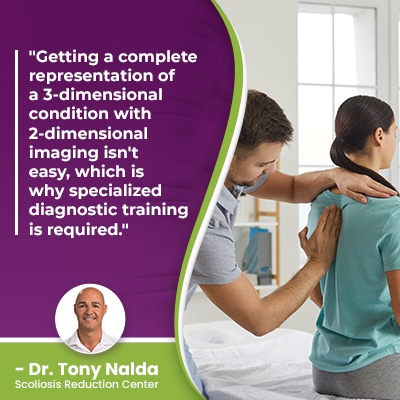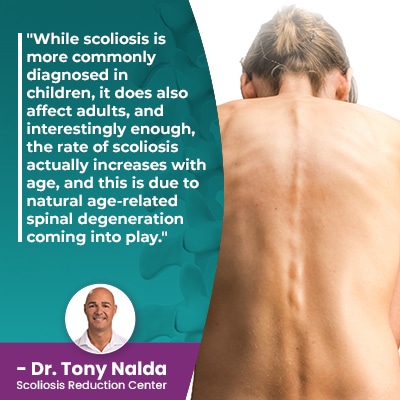Doctors Who Treat Scoliosis In Adults: Meet Dr. Tony Nalda

While a general practitioner can identify condition indicators and respond to a patient's symptoms of scoliosis, this is not the same as being able to actually correct a scoliosis. As a complex 3-dimensional progressive spinal condition, scoliosis necessitates the customization of treatment plans designed by a scoliosis specialist trained in multiple treatment modalities.
Patients have to decide how to treat their scoliosis, and this includes choosing a scoliosis treatment approach, and a doctor, to commit to. While there are many doctors who treat patients with scoliosis, this is not the same as treating the scoliosis itself; this requires the expertise of a scoliosis specialist like Dr. Tony Nalda.
If a patient receives a diagnosis of scoliosis, the next step is designing an effective treatment plan, but let's start with how a diagnosis is reached.
Table of Contents
How is Scoliosis Diagnosed?
Scoliosis is the development of an unnatural sideways spinal curve that also rotates, meaning it twists, and this rotational component is what makes scoliosis a 3-dimensional condition.
In addition, in order to be considered a true scoliosis, a scoliotic curve has to be of a minimum size: Cobb angle measurement of at least 10 degrees.
A patient's Cobb angle is determined during X-ray by drawing lines from the tops and bottoms of the curve's most-tilted vertebrae, at its apex, and the resulting angle is expressed in degrees.
Taking a scoliosis X-ray is not a simple process; it involves taking a series of complex measurements and images from a number of different angles for a true representation of what's happening in and around the spine.
 Getting a complete representation of a 3-dimensional condition with 2-dimensional imaging isn't easy, which is why specialized diagnostic training is required.
Getting a complete representation of a 3-dimensional condition with 2-dimensional imaging isn't easy, which is why specialized diagnostic training is required.
A general practitioner can order an X-ray, but the type of comprehensive measurements required is beyond the scope of anyone other than a specialist, capable of interpreting the results in a way that an effective and customized treatment plan can be designed around them.
In addition, the spine's rotational component has to be assessed as a patient's angle of trunk rotation (ATR) is an important piece of information.
Scoliosis is also a highly-variable condition ranging widely in severity, and the higher the Cobb angle, the more severe the condition:
- Mild scoliosis: Cobb angle measurement of between 10 and 25 degrees
- Moderate scoliosis: Cobb angle measurement of between 25 and 40 degrees
- Severe scoliosis: Cobb angle measurement of 40+ degrees
- Very-severe scoliosis: Cobb angle measurement of 80+ degrees
So through a physical examination that includes taking a patient's family and medical history, observing a patient's posture and gait, and performing an Adam's forward bend test, doctors can screen for condition indicators that warrant the need for further testing.
If indicators are present, a scoliosis X-ray is ordered to confirm a patient's Cobb angle and reach an official diagnosis of scoliosis.
Once a diagnosis is reached, the most important decision to be made is how to treat the condition moving forward, and this involves choosing a scoliosis treatment approach, and a doctor treats scoliosis in adults.
Adult Scoliosis
Current estimates of the Scoliosis Research Society have close to seven million people currently living with scoliosis in the United States alone, and as the leading spinal condition amongst school-aged children, scoliosis is more prevalent than many people realize.
Part of diagnosing scoliosis involves further classifying conditions based on key patient/condition variables: patient age, condition type, severity, and curvature location.
 While scoliosis is more commonly diagnosed in children, it does also affect adults, and interestingly enough, the rate of scoliosis actually increases with age, and this is due to natural age-related spinal degeneration coming into play.
While scoliosis is more commonly diagnosed in children, it does also affect adults, and interestingly enough, the rate of scoliosis actually increases with age, and this is due to natural age-related spinal degeneration coming into play.
The most prevalent form of scoliosis is adolescent idiopathic scoliosis (AIS), diagnosed between the ages of 10 and 18, with a rate of around 2 to 4 percent of adolescents having scoliosis, but studies have found higher rates in the aging population: between 12 and 20 percent, with one study supporting a rate as high as 68 percent in adults over the age of 60.
The results of these studies show that while scoliosis is more commonly diagnosed in children, the actual rate of scoliosis increases with age.
When it comes to treating scoliosis in adults, the two most common types are idiopathic scoliosis and degenerative scoliosis.
Adult Idiopathic Scoliosis
Idiopathic scoliosis is the most prevalent type to affect all ages, and the idiopathic designation means not clearly associated with a single-known cause.
When idiopathic scoliosis is diagnosed in adults, these are cases of adolescent idiopathic scoliosis that were undiagnosed and untreated during adolescence; this is a common scenario as particularly when mild, scoliosis isn't always easy to spot, and in children and adolescents, scoliosis isn't always painful.
Scoliosis doesn't become a compressive condition until adulthood, and it's compression of the spine and its surrounding muscles and nerves that causes the majority of condition-related pain.
With degenerative scoliosis, this is caused by natural age-related spinal degeneration, and it's most often the intervertebral discs that are the first spinal structures to deteriorate, and this impacts spinal health and function because the spinal discs provide the spine with structure (adjacent vertebrae attach to the disc in between), cushioning to prevent friction, flexibility, and act as the spine's shock absorbers.
Once the discs start to degenerate, it's difficult for the spine to maintain its natural curves and alignment, and degenerative scoliosis can develop as a result.
So now that we understand the main types of scoliosis to affect adults, let's talk about finding a doctor who treats scoliosis in adults.
Doctors Who Treat Adult Scoliosis: Dr. Tony Nalda
Another reason a scoliosis specialist is required to effectively correct a scoliosis is that as a progressive condition, scoliosis has it in its nature to worsen over time, so where a scoliosis is at the time of diagnosis is not indicative of where it will stay; only proactive treatment can work towards counteracting the condition's progressive nature.
Part of the focus of treatment is on counteracting the condition's progressive nature, and that isn't always a simple thing, although as growth is the trigger for progression, fast progression is less of a concern when treating scoliosis in adults.
As a leading scoliosis chiropractor, Dr. Tony Nalda of the Scoliosis Reduction Center has treated patients of all ages, including adults.
When it comes to treating adult scoliosis, the focus of treatment shifts somewhat. When treating scoliosis in children, the focus is on achieving a significant curvature reduction and holding it there throughout growth, but in adults, as the progressive trigger of growth has been removed, the focus is still on reducing the curve, but more so on reducing it back to where it was prior to the condition becoming painful.
Another focus of treatment is on stabilizing the spine because natural age-related spinal degeneration can make the spine increasingly unstable.
Pain management is also a facet of treating scoliosis in adults. However, patients don't want a doctor who treats patients with scoliosis as that tends to mean only the condition's symptoms are being addressed; they want a doctor who treats scoliosis, ideally a specialist trained in multiple treatment modalities.
While a traditional scoliosis treatment approach commonly funnels patients towards spinal fusion surgery, Dr. Tony favors a modern conservative scoliosis treatment approach that involves integrating multiple different treatment modalities so conditions can be impacted on every level.
He can apply condition-specific chiropractic care, physical therapy, corrective bracing, and rehabilitation because he is trained and certified in a number of different facets of scoliosis treatment: a CLEAR-certified scoliosis chiropractor, ISICO, SEAS, certified in Gomez Othodics, ScoliBrace, and he is Digital Motion X-ray certified so he can comprehensively X-ray and interpret X-ray results.
Conclusion
When it comes to finding a doctor who treats scoliosis, understanding the complex nature of the condition is important because not only is it a highly-complex progressive spinal condition to treat, different types of treatment can affect the spine differently.
Dr. Tony Nalda first got into chiropractic leadership after a visit to a chiropractor changed his life as an adolescent.
When debilitating migraines were disrupting his love of sports and quality of life, a chiropractor was the only professional able to impact his condition so he could regain control over his life and health.
After noticing that chiropractic care for scoliosis patients was limited, he set out to expand the techniques and treatment modalities used in conservative scoliosis treatment, and he now has one of the world's most-successful non-surgical scoliosis treatment centers.
So if you are an adult recently diagnosed with scoliosis, don't hesitate to reach out to the Scoliosis Reduction Center to benefit from the expertise of world-renowned scoliosis chiropractor: Dr. Tony Nalda.
Dr. Tony Nalda
DOCTOR OF CHIROPRACTIC
After receiving an undergraduate degree in psychology and his Doctorate of Chiropractic from Life University, Dr. Nalda settled in Celebration, Florida and proceeded to build one of Central Florida’s most successful chiropractic clinics.
His experience with patients suffering from scoliosis, and the confusion and frustration they faced, led him to seek a specialty in scoliosis care. In 2006 he completed his Intensive Care Certification from CLEAR Institute, a leading scoliosis educational and certification center.
About Dr. Tony Nalda
 Ready to explore scoliosis treatment? Contact Us Now
Ready to explore scoliosis treatment? Contact Us Now





